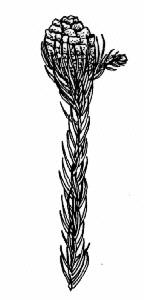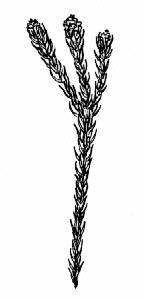
Home
Mission
Overview of Project
Project Staff
Sponsors
Achievements
Checking, Illustrations
Upcoming Activities
Id and Species Lists
Protea Information
Protea Gallery
Growing Proteas
Interim Dist. Maps
Publications
Afrikaanse Inligting
![]()
Extinct Protea Species
It is not generally realized that we are on the verge of losing our proteas.  More than one-third of our
protea species are listed in the Red data book of plants, which lists species
threatened or potentially threatened by mankind. Amongst our proteas some 35 species are
considered to be ‘Endangered with extinction", and a further 46 species are
"Vulnerable to extinction". The former category is used for species in imminent
danger of extinction, whereas the latter is used for species that will become extinct if
the threats to which they are exposed continue unabated. Another 76 species are listed as
"Rare" because their small population or limited distribution range would make
them vulnerable if their habitat were to be developed or transformed in any way.
More than one-third of our
protea species are listed in the Red data book of plants, which lists species
threatened or potentially threatened by mankind. Amongst our proteas some 35 species are
considered to be ‘Endangered with extinction", and a further 46 species are
"Vulnerable to extinction". The former category is used for species in imminent
danger of extinction, whereas the latter is used for species that will become extinct if
the threats to which they are exposed continue unabated. Another 76 species are listed as
"Rare" because their small population or limited distribution range would make
them vulnerable if their habitat were to be developed or transformed in any way.
It is vital that Red data book species are preserved, and they should not be picked, disturbed or damaged in any way. If you believe you may have found a new population or locality of a Red data book species, please inform your local branch of the Wildlife Society, Botanical Society or Mountain Club, and they will inform the relevant authorities. If you live near a population of a Red data book species, you may consider setting up a watchdog group in order to monitor it and foster its survival. Contact the Botanical Society for further guidelines on how best to achieve this.
Please be aware that many of these species are very susceptible to trampling as well as to disease such as dieback, rootrot or any other fungal and bacterial disease that you may carry on your shoes from your garden into the wild. Thus it is vital that you keep your distance lest you kill them.
The following three species are extinct both in the wild and in cultivation. The Red data book definition of ‘Extinction’ is that the species has not been recorded during the last 50 years, or it has been eliminated (by, for example, agriculture, urbanisation or flower-picking) from all known colonies.
Mace Pagoda - Mimetes stokoei
Thomas Stokoe discovered this species in 1922, but did not remember where he had seen it. Three years later, however, he found its flowers for sale in the Adderley Street market, and the flower-picker led him to the only population ever known: in the Highlands State Forest above Kleinmond. It is not known precisely why the species became extinct, but the following hypothesis seems likely. The exact locality was kept a close secret, and only after the area had been bucket to set up an experimental orchard in the early 1960s was it realized that the habitat of M. stokoei had probably been destroyed. A single plant grew from seed in the soil and a tripod was erected to protect it. Ironically, wind broke the plant against the tripod before it had a chance to flower. The species has not been seen again.
Have a look at The Case of the Mace Pagoda - Mimetes stokoei and a picture of the Mace Pagoda - Mimetes stokoei.
Wynberg Conebush - Leucadendron grandiflorum
L. grandiflorum was described in 1806 only from a male plant  grown in George Hibbert’s garden in
England. No herbarium specimen has been found, so a description and a drawing are the only
existing evidence that this species once occurred. Seed was collected on ‘Wynberg
Mountain’ (presumably Wynberg Hill’ by James Niven in about 1800, and no plant
has been seen since. Nothing else is known about this species, although it is clearly
related to the Crown Conebushes. However, some confusion has been caused by the name L.
grandiflorum having also been given to what is now L. tinctum and allied
species in the Sun Conebush grouping.
grown in George Hibbert’s garden in
England. No herbarium specimen has been found, so a description and a drawing are the only
existing evidence that this species once occurred. Seed was collected on ‘Wynberg
Mountain’ (presumably Wynberg Hill’ by James Niven in about 1800, and no plant
has been seen since. Nothing else is known about this species, although it is clearly
related to the Crown Conebushes. However, some confusion has been caused by the name L.
grandiflorum having also been given to what is now L. tinctum and allied
species in the Sun Conebush grouping.
If the Wynberg Conebushes’ habitat requirements were similar to those of the closely related L. globosum, it probably occurred on the southern side of Wynberg Hill near the crest, between Kirstenbosch and the Wynberg Military Hospital.
More on Wynberg Conebush - Leucadendron grandiflorum
Wolseley Conebush Leucadendron spirale
| This Conebush is undoubtedly the ‘ugly duckling’ in the genus. Describing it
in 1809, Richard Salisbury noted that ‘cuttings grow freely, but possessing little
beauty it should only be admitted in extensive collections’. Indeed, few people would
recognise it as a Conebush, as its leaves are small and ericoid, and the fully mature
cones, are only 20 mm in diameter. L. spirale has been collected only four times in the past: James Niven found it in 1801 at the Breede River; Leopold Mund collected it at the same locality in 1819; James Bowie gives as his locality the swamps at Soetmelkrivier and Langklooof (but he has a reputation for giving incorrect localities); and Alfred Meebold collected it in 1933, describing the locality as ‘Wolseley, health, containing only few species, but river ground and swampy ground, few hours only’. If the Breede River and Wolseley localities are correct most of its habitat has probably been ploughed up, but small pockets of plants may still exist. |
|
A R1000 Reward of is offered for finding a confirmed plants.
Diminutive Powderpuff - Sorocephalus tenuifolius
The runt of the Powderpuffs (or Clusterheads), not only is this species difficult to see in the wild, but it can also be easily mistaken for Palmiet Unispoon - Spatalla prolifera. It was first collected by James Niven in about 1800 in ‘alpine, moist places near the Breede River’, and was subsequently grown in George Hibbert’s garden, near Clapham, in England. Christian Krauss also collected it ‘in stony ground near Elim’. Both these localities are considered erroneous as they have not been relocated. However, atlassers should keep an eye out for this species in those localities.
In about the 1940s Thomas Stokoe found a population of S. tenuifolius on the farm Arieskraal in the Palmiet River Valley near Elgin. This population, comprising about 700 plants, was ploughed up in 1985 for an apple orchard. The Cape Department of Nature Conservation rescued and grew some plants, giving them to the Kirstenbosch National Botanical Garden. Unfortunately they did not survive and it was believed that the species became totally extinct in 1987.
However, within months of SASOL Proteas being published a new population of the species was discovered. Ironically this new population is in the middle of one of the dams required in Kogelberg to supply Cape Town with its water needs. For the time being the species is safe. Interestingly, it seems to like a disturbed habitat, being most frequently found on the edge of eroding shale in seepage areas.
Have a look at a picture of the Diminutive Powderpuff - Sorocephalus tenuifolius
Back Proteas in History

